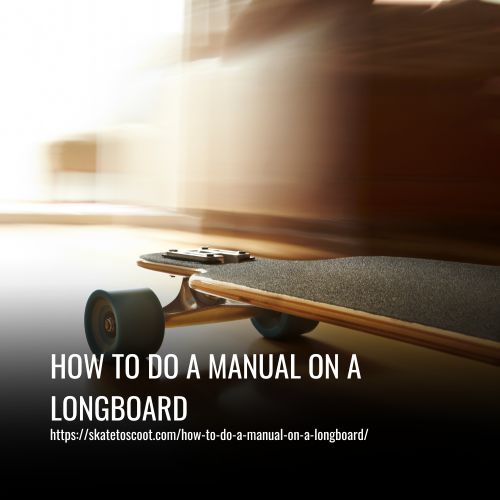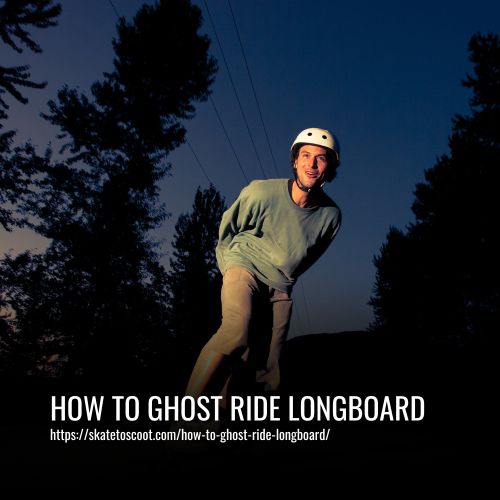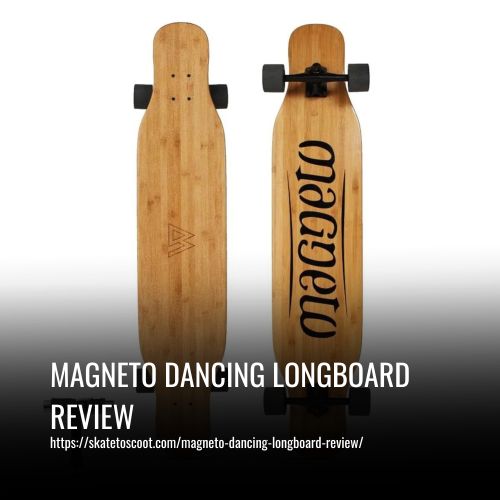As an Amazon Associate we earn from qualifying purchases.
A manual is a popular trick in skateboarding that involves shifting the skateboarder’s weight to either the front or back of the board to raise either the front or back wheels off the ground. The goal is to keep the tail or nose of the board from touching the ground while maintaining balance and control. This trick requires a good sense of balance and coordination.

Easy Steps to Manual on a Skateboard
The manual is a skateboarding trick that can enhance your skills and add style to your repertoire. While it may appear challenging initially, learning how to manually on a skateboard is achievable. Here are some easy steps to help you master the art of manual:
- Roll forward and position your feet: Start by rolling forward at a moderate, controlled pace. Place your rear foot on the tail of the skateboard, covering a significant portion of its curvy part. Position your front foot towards the center of the front trucks.
- Bend your knees: Bend your knees slightly before attempting to manually. This will help you maintain balance and make subtle adjustments to your stance during the trick.
- Put your weight on the back foot and lean forward: To lift the skateboard’s front wheels off the ground, transfer your weight gradually and gently onto your back foot while leaning slightly forward with your upper body.
- Stay balanced: Focus on maintaining your balance. As you roll forward with the front end of the board in the air, make small adjustments to your weight distribution. If you start to sway forward, lean back and put more weight on the tail. If you find yourself slipping backward, lean forward slightly.
- End the manual: To end the manual, gently shift your weight from the rear foot to the front foot. Restore your upper body to a natural upright posture. The front of the skateboard may fall to the ground as a result.
By following these easy steps, you can learn how to manually on a skateboard and add this popular trick to your skateboarding repertoire. Remember to practice regularly and wear protective gear to ensure a safe and enjoyable skateboarding experience.
What You Need
To do a manual on a longboard, there are a few key things you’ll need. First, make sure your longboard is in good working condition. Check the wheels, trucks, and bearings to ensure they are in proper working order. You’ll also want to wear protective gear such as elbow and knee pads to prevent injuries.
Next, find a suitable location to practice your manual. Look for an open area with level ground and no obstructions. This will provide a safe and controlled environment for you to work on your skills.
In terms of equipment, it’s important to have the right longboard for the task. Beginners may want to start with a comfortable board that offers good stability and control. A pintail longboard is a popular choice for novice riders. It provides a stable platform for learning basic and challenging tricks.
Additionally, consider the type of wheels on your longboard. Larger wheels will provide a smoother ride and more stability, while smaller wheels are better suited for freestyle tricks. A wheel bite check is also important to prevent the wheels from rubbing against the deck.
Variations of the Manual in Skateboarding
Once you’ve become comfortable with the basic manual, you can challenge yourself by trying out some variations. These variations will require different techniques and skills, but they will also help you improve your balance and control on the skateboard.
- Nose manual: To achieve balance on a skateboard, shift your weight towards the front of the board, lifting the back wheels off the ground and balancing on the front wheels.
- English manual: To perform an English manual, position your back foot over the back truck and your front foot under the nose of the board. Utilize your front toes to elevate the nose of the board into the manual position.
- Swedish manual: The Swedish manual is the opposite of the English manual. Place your front foot over the front truck, your back foot underneath the tail of the board, and use your back toes to hook the board up into the nose manual position.
- Hang ten manual: To achieve this maneuver, position both of your feet together on the nose of the board and maintain balance solely on the front wheels. This skill necessitates a significant amount of balance and control.
- Heelie: The heelie is the opposite of the hang ten manual. Place both of your feet next to each other on the tail end of the board and balance only on the back wheels.
- Fakie manual: Perform a manual while riding fakie, which means riding with your non-dominant foot at the front of the board.
- One-foot manual: Challenge yourself by balancing on one foot while performing a manual. Lift your other foot off the ground and keep it parallel to the board.
- One-wheel manual: This variation requires a lot of skill and balance. Try balancing on only one of the back wheels while performing a manual.
Remember to always practice these variations in a safe and controlled environment. Start with the easier variations and gradually progress to the more difficult ones as you become more comfortable and confident on the skateboard.
Things to Consider When Doing a Manual:
When attempting to do a manual, it’s important to follow the instructions outlined in this article. Be sure to position your feet correctly, use your weight to lift the front wheels off the ground, and make small adjustments with your upper body to stay balanced.
- Prepare your board: Before attempting a manual, make sure your skateboard is in good condition. Check for any loose or damaged parts, especially the trucks, and wheels. Tighten any loose bolts and ensure that the wheels rotate smoothly.
- Wear protective gear: Safety should always be your top priority. When doing a manual, wear a helmet to protect your head from any potential falls or accidents. Additionally, consider wearing knee pads, elbow pads, and wrist guards to protect other vulnerable areas of your body.
- Choose the right board: Selecting the right board for manual tricks is crucial. Look for a board that is comfortable and stable, with a sturdy deck. Pintail longboards are often preferred for their stability and control. Larger wheels can also provide a smoother ride and better balance during a manual.
- Start with the basics: If you are a beginner, it is essential to start with regular manuals before attempting more challenging tricks. Regular manuals involve lifting both the front and rear wheels off the ground while maintaining balance. Focus on mastering this foundational skill before progressing to other tricks.
- Find your center of mass: Understanding your center of mass is vital for maintaining balance during a manual. The center of mass is typically just above the waistline and slightly towards the rear foot. By adjusting your weight distribution and finding your center of mass, you can control the duration and stability of your manual.
- Practice board control: Developing good board control is key to successfully executing a manual. Start by practicing deep turning and controlled speed on flat ground before attempting manuals. This will help you get accustomed to the feel of the board and improve your overall balance and control.
- Focus on weight transfer: Transferring your weight from the front foot to the back foot is a crucial step in performing a manual. Start by shifting your weight gradually and maintaining a smooth transition. Keep your body relaxed and avoid sudden movements, as this can throw off your balance.
- Practice in a controlled environment: Find a smooth, open area with a flat surface to practice your manuals. Avoid crowded areas or busy streets where there is a higher risk of accidents. It is also advisable to have a friend or experienced skater present to provide guidance and support.
- Be patient and persistent: Learning how to do a manual takes time and practice. Don’t get discouraged if you don’t get it right away. Keep practicing consistently and gradually increase your skills and confidence. With persistence and patience, you will eventually master the art of manuals and be able to execute more complex skateboard tricks.
- Start slow and practice safety: It is important to avoid attempting any tricks in an unsafe environment. Begin by slowly pushing the board forward and balancing on it until you feel comfortable with your balance. You should also wear protective gear such as a helmet, elbow pads, and knee pads when practicing longboard tricks.
FAQs
A manual is a skateboarding trick where the rider balances on either the front foot (nose manual) or back foot (rear foot manual), while keeping the other end of the board airborne.
To maintain balance, distribute your weight evenly by placing your feet over the bolts, keeping your knees slightly bent, and focusing on the center of mass. Start with small manual movements before progressing to longer distances.
To avoid the board tipping over, it’s important to keep your eyes focused on a fixed point ahead, rather than looking at your feet. This will help you maintain control and balance.
It is recommended to learn basic tricks such as ollies, kickflips, and shove-its before attempting manuals. These tricks will help you develop the necessary board control and balance required for a manual.
Practice regularly and gradually increase the distance of your manuals. Start with a comfortable board and larger wheels to enhance stability. It’s also important to wear protective gear such as a helmet, knee pads, and elbow pads to ensure safety.
Conclusion:
Learning how to do a manual on a longboard is not only a thrilling skill to master, but it also opens up a whole new world of tricks and techniques to explore. So grab your board, find a smooth surface, and get ready to defy gravity and impress everyone around you.
Remember, practice makes perfect, so don’t be discouraged if it takes some time to nail down. With determination and a little bit of balance, you’ll be cruising on one wheel in no time. Happy riding!
Amazon and the Amazon logo are trademarks of Amazon.com, Inc, or its affiliates.



